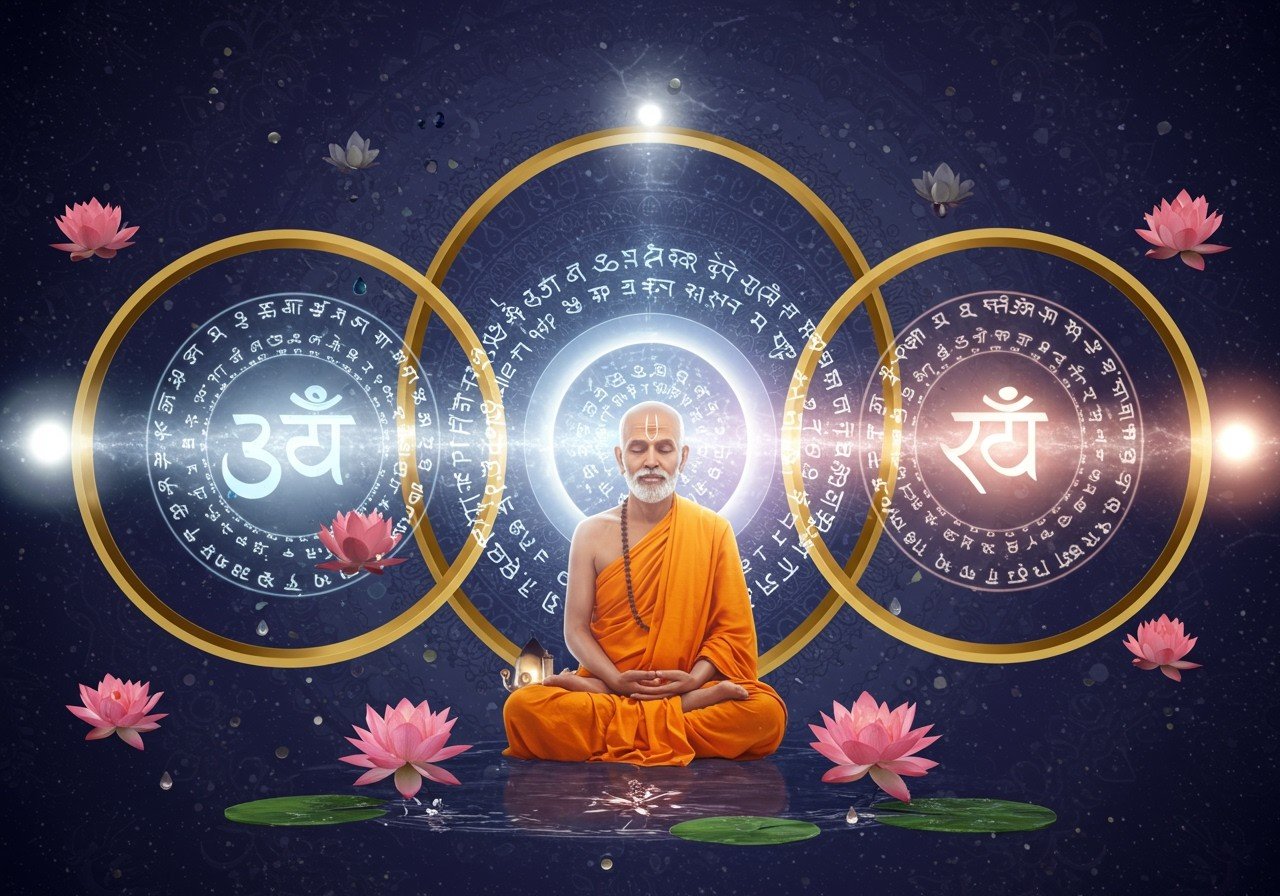
Saccidānanda, a profound concept in Indian philosophy, embodies the essence of existence, consciousness, and bliss. This idea holds deep significance for those who value traditional Indian spiritual and cultural practices. For culturally rooted Indians, understanding Saccidānanda offers a path to inner peace and harmony. Those seeking a deeper understanding of their spiritual journey can explore articles like Meditation and Mantras: Your Path to Inner Peace and Enchanting Tales of Lord Krishna: Divine Stories and Timeless Lessons on poojn.in.
The Core of Saccidānanda: Existence, Consciousness, and Bliss
Sat (सत्): The Essence of Being
‘Sat’ represents the reality and truth of existence. It is the simple fact that things exist, connecting us with all things through common existence. In everyday life, ‘Sat’ reminds us of the interconnectedness of all beings and the universe. This understanding enriches our daily experiences, fostering a sense of unity. Enhance your connection with the divine by exploring our range of Laddu Gopal murtis at poojn.in.
Chit (चित्): The Light of Consciousness
‘Chit’ refers to consciousness or awareness. It signifies our ability to know and understand the world around us. This consciousness links us to all things through knowledge. By embracing ‘Chit’, we nurture our relationship with wisdom and clarity, enhancing our perception of life. Discover the power of sacred symbols with our collection of Rudraksha and Tulsi products available on poojn.in.
Ānanda (आनन्द): The Joy of Bliss
‘Ānanda’ embodies pure happiness and bliss. It is the joy that connects us with everything through love. Experiencing ‘Ānanda’ brings a sense of fulfillment and contentment, transcending material pleasures. It guides us towards spiritual enrichment and satisfaction. Deepen your spiritual practice with authentic puja items like incense sticks and camphor from poojn.in.
Saccidānanda in Indian Philosophy: A Path to Liberation
In Vedanta and other Indian philosophies, Saccidānanda is seen as the ultimate state of liberation or moksha. It provides a framework for understanding life beyond the material realm. Saccidānanda influences Indian literature, art, and rituals, reflecting its deep cultural roots. For modern Indians, it offers a way to find balance in a fast-paced world, blending traditional values with contemporary challenges. By integrating Saccidānanda into daily practices, individuals can achieve spiritual fulfillment. Consider incorporating Pancha Pratishtha into your spiritual practices to establish a divine presence.
Mastering the Pronunciation of Saccidānanda
Pronouncing ‘Saccidānanda’ correctly preserves its sacredness. Break it down as ‘Satch-ee-daan-an-da’. Each syllable carries vibrational energy that enhances understanding and experience. Listening to audio clips or engaging in guided pronunciation sessions can be helpful.
Cultural and Spiritual Relevance Today
Saccidānanda remains culturally relevant in India today. It informs daily rituals, celebrations, and spiritual practices integral to Indian cultural identity. For those seeking balance between tradition and modernity, Saccidānanda serves as a spiritual anchor. It bridges the gap between age-old wisdom and contemporary life. Saccidānanda appears in modern spiritual discourses and online communities. These platforms make this timeless philosophy accessible to a wider audience, enriching their spiritual journey.
By embracing Saccidānanda, individuals connect with their true nature and experience a unified essence of existence, consciousness, and bliss. This journey leads to self-realization and fulfillment, echoing the timeless wisdom of Indian philosophy. Learn more about the significance of rituals with Unveiling the Profound Significance of Aarti available on poojn.in.
FAQs on Saccidānanda
What is the meaning of Saccidānanda? Saccidānanda, a Sanskrit term, combines ‘Sat’ (truth/existence), ‘Cit’ (consciousness), and ‘Ānanda’ (bliss), describing ultimate reality in Hindu philosophy. It represents the interconnectedness of these three fundamental attributes of the divine.
Why is Saccidānanda significant in Hinduism? It represents the true essence of the divine, emphasizing its eternal and unchanging qualities. It highlights the interconnected nature of truth, consciousness, and bliss as fundamental divine attributes. It is a core concept in understanding the nature of Brahman and the path to liberation.
How do you pronounce Saccidānanda? The pronunciation is “Satch-ida-ananda,” with even stress on each syllable for accuracy. Paying attention to the correct pronunciation enhances the understanding and appreciation of this sacred term.
Is Saccidānanda related to any specific deity? While it describes ultimate reality, it’s often associated with Brahman, signifying the divine’s unchanging, eternal aspect rather than a specific deity. It is a quality attributed to the ultimate reality rather than a specific divine form.
Can Saccidānanda be experienced in daily life? Yes, through meditation and devotion, individuals can experience Saccidānanda, feeling truth, consciousness, and bliss in their daily lives. These practices facilitate a deeper connection with one’s inner self and the divine.
How does understanding Saccidānanda help in spiritual growth? It helps individuals recognize their consciousness’s eternal, blissful nature, fostering spiritual growth and a deeper divine connection. It provides a framework for understanding the true nature of reality and the self.


